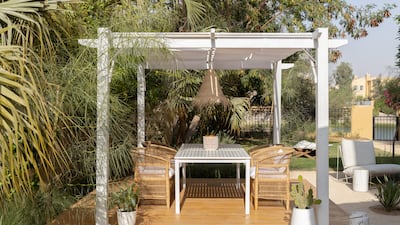Quite as with planet-saving slow fashion, with interiors, it is recommended you spend a little more and buy good quality products in smaller quantities, some of which may even remain in your home for years. Shopping with consideration and care enables you to avoid spending money on low-quality products that wear out quickly and produce more waste.
Here are eight natural and sustainable materials to look for the next time you’re picking up a piece of furniture or decorative accessory.
1. Bamboo – for soft bedding
It’s not just bohemian or tiki interiors that come from bamboo, which is a very versatile material. It can be used for furniture, sure, but the fibre is also used for textiles and can yield the softest bedding you’ll find in the market.
With a high rate of growth (new stalks can grow in less than three years), bamboo does not require pesticides to thrive or replanting, making it a fast and renewable natural resource.
2. Recycled plastic – for rugs
Living in a world dominated by plastic, it comes as no surprise that several interior designers are recycling the material to create gorgeous homeware. Look out for it the next time you’re in the market for tables and chairs, while even some lighting solutions use recycled plastic. A current favourite is ferm Living’s indoor-outdoor rugs in recycled Pet yarns, which are waterproof and oh-so stylish.
3. Natural textiles – for the linen drawer
Make organic cottons and linens a go-to for home textiles, for not only their sustainability, but also their look and durability. Look out for a Gots certification, which ensures the fabric meets ecological as well as ethical standards, going all the way up to the supply chain.
4. Jute – for wall decor and waste baskets
This natural fibre is also a rapidly renewing one, which makes it a strong contender on this list. With its warm appearance, it can add a cosy vibe, and can be used in the form of a rug, basket or wall decor. Tribe Dubai has a beautiful selection of handmade jute wall hangings.
5. No-VOC paint – for personal and planetary health
The strong aroma that paint exudes is courtesy of harmful chemicals called VOCs. These days, many big-name brands offer natural options such as water-based paints, with low or no VOCs. This renders the paint non-toxic, so it doesn’t pose a threat as a hazardous waste, and is better for the environment as well as for you and your family.
6. Plants – for a fresh look and fresh air

Greenery is your best friend when it comes to decorating sustainably. Easily found, highly decorative and available for every personality and pocket, plants will beautify your home even while cleaning the air, by absorbing harmful chemicals.
7. Seagrass – for hand-made knick-knacks
A natural alternative to plastic, this plant is both sustainable and biodegradable. Most commonly seen in baskets, rugs and placemats, seagrass material is often handwoven, and so also ties into the handmade trend we should be adopting (more on this below).
8. Sustainable wood – for all things that need wood
Chopping down trees should never be your first option, so either look for an FSC-certified label, which shows the wood is harvested in a responsibly managed forest, or turn to recycled or reclaimed wood.
The eco-friendly material can be used for pretty much every home decor need, and is at the top of my list for materials that fit with the slow-living trend.
These materials aside, here are three other ways to make yours a more conscious yet still stylish household:
Adopt all things handmade
Buying handmade homewares is the perfect ingredient for a sustainable home. Not only are you directly supporting someone’s livelihood, but you also know for certain that the item has been made under a fair-trade environment. While you might pay a premium, you can rest assured the item will last longer than a mass-produced, machine-made alternative.
Add antiques for a touch of ethical charm

















Simply put, giving second life to a used object reduces its – and your – carbon footprint. Whether you have inherited a piece or found something scouring a vintage market, antiques are a wonderfully ethical way to add character to your home.
Don’t shy away from the neutral
While colour, pattern and texture trends come and go, invest in a selection of neutral tones, be it coffee-table books, candles or ceramics. Use this collection of accessories to style your home: their neutral colours mean that they will inevitably fit in any room, and you can mix and match them every year, thus creating new looks without the need to buy more.
Valentina Piscopo is an interior stylist, furniture designer and founder of Kuky, the online interior design platform

